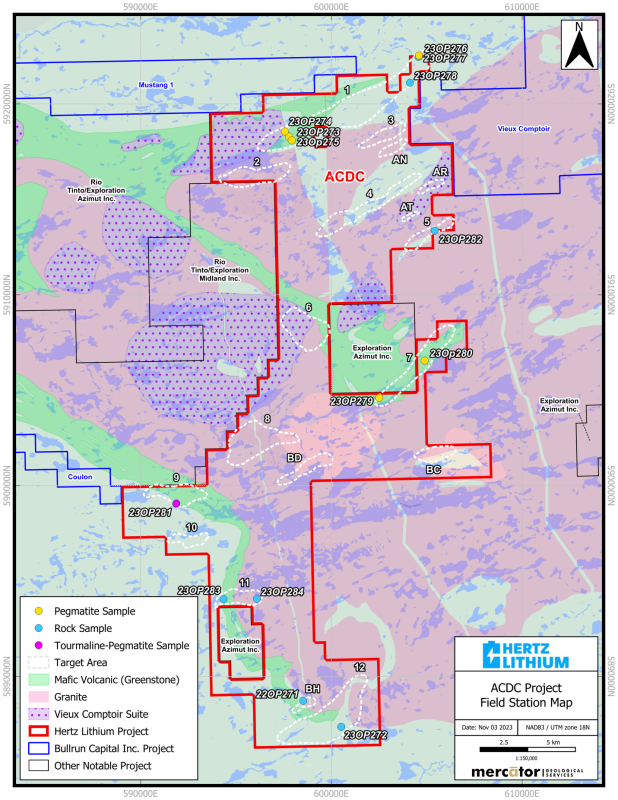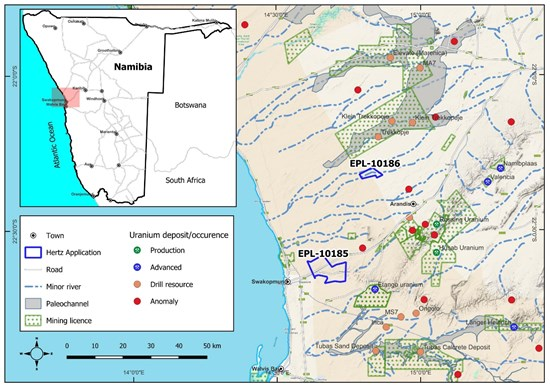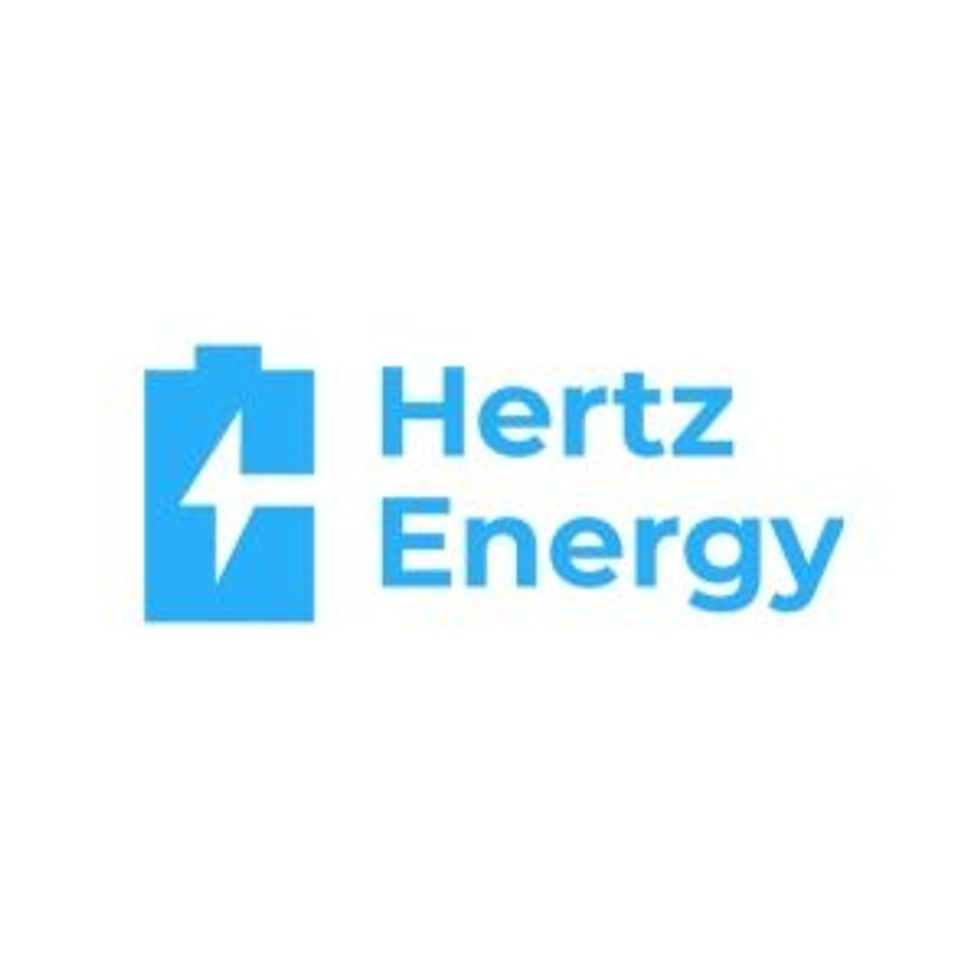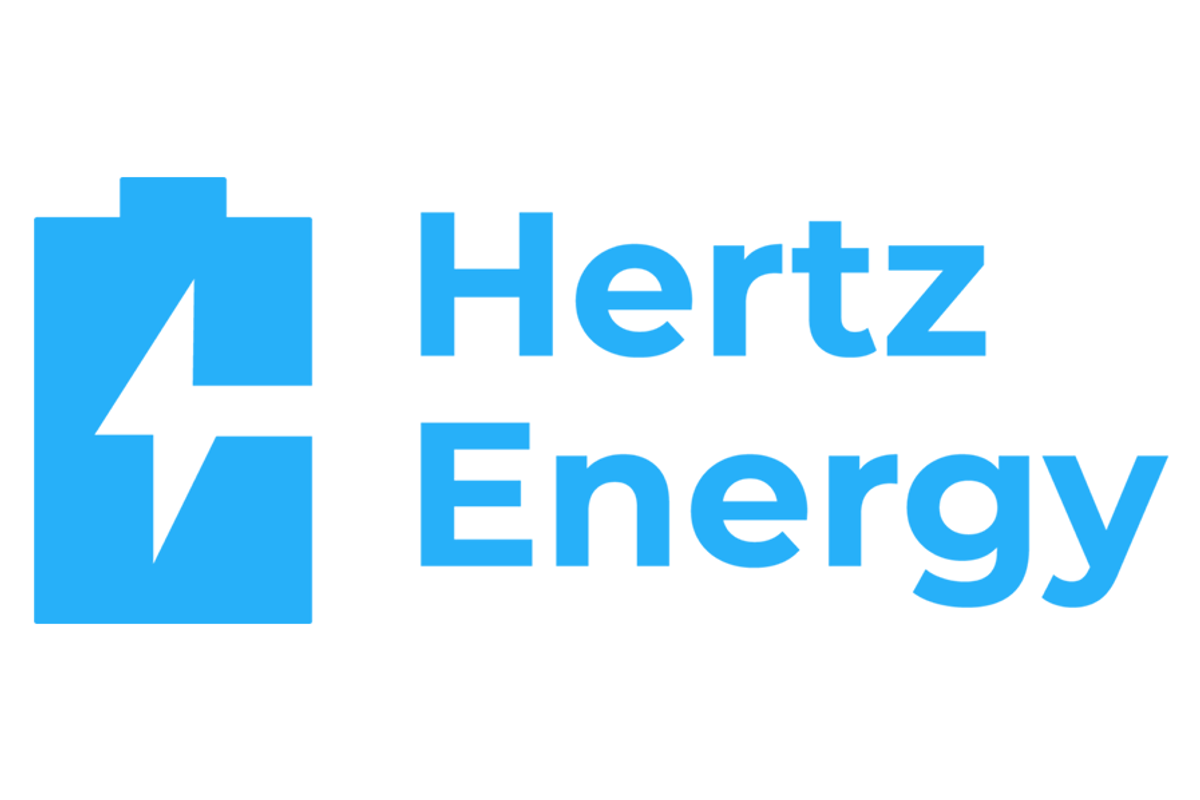
December 19, 2024
Hertz Energy Inc. (“Hertz” or the “Company”) (CSE: HZ; OTCQB: HZLIF; FSE: QE2) is pleased to provide an update on the Company’s critical minerals projects, including antimony, lithium, and uranium and announces proposed financing.
ANTIMONY
The Company is focused on exploring its two antimony projects aggressively with use of Quebec Critical Minerals Flow thru funds at the Harriman Antimony Project in Quebec and Canadian Flow thru funds at its Lake George Antimony Project in New Brunswick.
LAKE GEORGE ANTIMONY PROJECT: NEW BRUNSWICK, CANADA
The Property is located in the southwestern part of the Province, approximately 30 km southwest of the city of Fredericton.
The Property is comprised of 93 mineral claims within two claim blocks recently staked by the Company for a total area of approximately 2,104.5 hectares. The Property surrounds the past-producing Lake George Antimony Mine ("Lake George Mine") and is considered an exploration-stage Antimony-Gold (Sb-Au) prospect located immediately along strike to the southwest and northeast, as well as downdip to the north of the historical Lake George Mine. The Property benefits from excellent road access, hydroelectric power, and nearby available personnel for field and exploration activities.
The Lake George Mine was formerly the largest antimony producer in North America with a long history of production spanning from 1876 to 1996. The mine closed in 1996 due to falling antimony prices. From 1972 to 1981, 34,417 tonnes of concentrate grading 65% to 66% Sb was produced from the first deposit. Then from 1985 to 1990, approximately 1 Mt grading 4% Sb was extracted from a second deposit (Caron, 1996). The mine also contained molybdenum (Mo), tungsten (W), and Au mineralization. Infrastructure on the Lake George Mine includes 3 shafts, underground development on 10 levels, some remaining surface buildings, and a tailings pond. The deepest level of the mine is approximately 400 m below the surface. The Lake George Sb-Au Mine currently represents one of the Top 3 antimony occurrences in the Province of New Brunswick. More info can be found at: https://hertz-energy.com/lake-george-project/
HARRIMAN ANTIMONY PROJECT: QUEBEC, CANADA
The Harriman Property is an exploration stage antimony project located approximately 17 km northeast of the town of New Richmond in the Gaspé Region of Québec (Figures 1, 2). The Gaspé Region is known for a variety of significant mineral deposits, most notably the Mine Gaspé Copper Mine, currently being developed by Osisko Metals. The Harriman Property benefits from good road access, hydroelectric power, port access, and nearby available manpower.
The Harriman Property is strategically located at the intersection of the major ENE trending Restigouche Fault and Grand Pabos Fault with a second order northeast-trending fault hosting numerous antimony and gold showings (Figure 3).
The Property was developed by compiling and reviewing historical antimony (Sb) and gold (Au) showings from the Québec government geoscientific database known as SIGÉOM. The Property area was defined by a series of four antimony showings, all hosted along a northeast-trending fault structure (Figure 4). Historical results from the nearby showings along the northeast-trending fault include 2.32% Sb, 3.36 g/t Au (Harriman-2), 43.75 Sb, 3.4 g/t Au (New Richmond), 4.8% Sb, 7.89 g/t Au and 15.35% Sb (Harriman-4 Sud) (source: SIGÉOM).
The Harriman Property of Hertz includes the Harriman-4 Sud showing returning 15.35% Sb and 0.07 g/t Au from a historical grab sample of a massive stibnite vein in altered sediments. The nearby Harriman Gold occurrence, located 300 m to the northwest, returned an assay of 22.4 g/t Au from a grab sample. These showings and much of the property have had limited previous exploration and has not had any historical drilling.
Hertz Energy has completed a program of geological mapping and prospecting. The crew’s focus was in the area of favourable geology, particularly surrounding the historical showings as well as stream sediment and prospecting for new antimony and gold showings. Results are expected in the coming weeks. More info can be found at: https://hertz-energy.com/harriman-antimony-project/
LITHIUM PROJECTS
AGASTYA LITHIUM PROJECT: QUEBEC, CANADA
The Agastya Lithium Property is comprised of 209 mineral claims covering approximately 10,650 hectares located in the Province of Québec and consists of three non-contiguous claim blocks along the greenstone belt that hosts the Adina, Trieste, and Galinée properties. These adjacent properties are known for their significant LCT (Lithium-Cesium-Tantalum) pegmatite potential hosted within greenstone/ metasediment packages:
- Winsome Resources – Adina Lithium Project: One of the Top 3 largest lithium resources in North America with an Indicated Mineral Resource of 60.5 Mt at 1.14% LiO and Inferred Resource of 15.9 Mt at 1.17% LiO using a 0.5% LiO cut-off (source: NI 43-101 Technical Report on PEA and MRE for Adina Lithium Project authored by Synectiq Inc. with a report date of September 30, 2024 and filed under Winsome’s SEDAR+ profile). Winsome also has an exclusive option to acquire the nearby Renard Operation, a fully permitted, former diamond mine located 60 km south of Adina with a convertible processing facility for future lithium production.
- Loyal Lithium – Trieste Lithium Project: Discovery of six spodumene-bearing pegmatites including a significant drilling result of 31.8 m at 2.2% LiO.
- 50% Azimut Exploration / 50% SOQUEM JV – Galinée Lithium Property:Drilling results include 1.62% LiO over 158.0 m including 3.33% LiO over 29.6 m, and Galinée features a 20 km long lithium-cesium anomaly.
- Rio Tinto/Midland Galinée Project: Spodumene-bearing pegmatite dykes discovered over several hundred metres along a 7 km favourable contact zone. Significant drilling results include 1.38% LiO over 37.86 m including 1.88% LiO over 21.35 m.
The Agastya Property covers the western extent of the greenstone belt that trends through Trieste, Adina, and Galinée. Greenstone belts are known to host LCT pegmatite mineralization and are commonly targeted by exploration companies as they are favourable hosts for lithium and other valuable metals including gold. Recent discoveries surrounding the Agastya Project have been announced by Azimut Exploration and Soquem at their Galine Project: I am running a few minutes late; my previous meeting is running over.
https://azimutexploration.com/site/assets/files/72...
https://azimut-exploration.cl1.adnetcms.com/site/a... 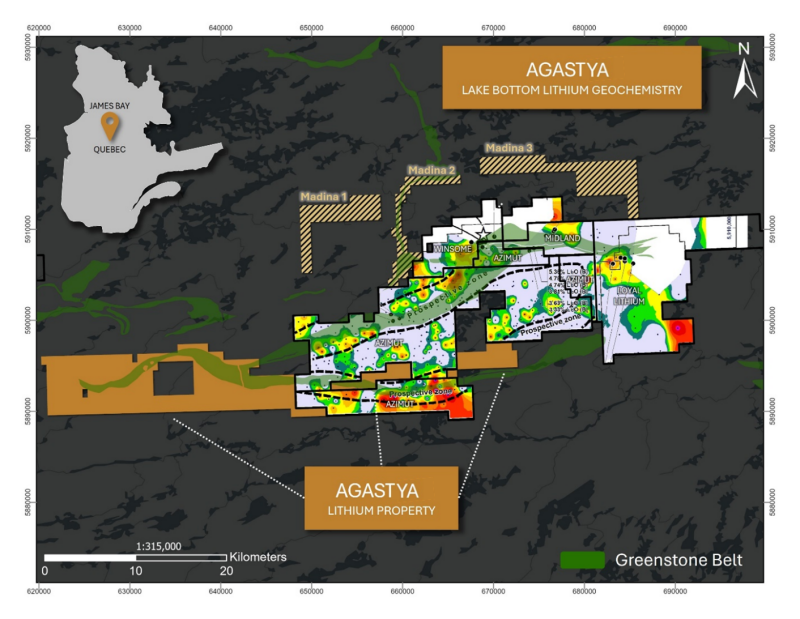
Click Image To View Full Size
AC/DC LITHIUM PROJECT: QUEBEC, CANADA
The AC/DC property encompasses amphibolized mafic volcanics (greenstone) of the Rouget and Corvette Formations and plutons of the Vieux Comptoir Intrusive suite, similar to the geological setting that hosts both the Cancet and Corvette lithium projects. Both Cancet and Corvette are hosted by amphibolite rocks of Guyer Group, which is similar in age to the Rouget formation (Mesoarchean).
The northwest-trending mafic volcanics of Rouget and Corvette Formations and associated Vieux Comptoir suites continue northwest to the adjacent Rio Tino/Exploration Azimut Inc. and Rio Tinto/Exploration Midland Inc. project areas.
These are advanced rocks, typically characterized by a pegmatitic texture, a granitic composition and contain several minerals such as biotite, muscovite, tourmaline, garnet, beryl and spodumene. These rocks are also known to host K-feldspar granite phases in pegmatite form which may host an abundance of spodumene.
Based on the results of the remote sensing data analysis and processing twelve (12) anomalous target areas have been identified across the two properties.
- 5 primary and numerous smaller secondary targets are identified at the AC/DC property.
- 7 primary and numerous smaller secondary targets are identified at the La Fleur property.
Strike lengths of the individual target trends range in length from 1 to 15km in length and are between 100m to 1,000m in width and are generally oriented in a northeasterly trending direction.
Each of the anomalous trends contain numerous dyke-like structures identified from high resolution orthophotography. Individual dyke-like structures range in length between 20 –500m or greater, often occur in clusters and are generally noted to occur in conformant orientation to the target trends.
Hertz is aggressively advancing exploration at the AC/DC Project and will provide updates upon receipt of exploration results.
MAP OF AC/DC LITHIUM PROJECT AND RIO TINTO ADJOING KAANAAYAA PROJECT
SNAKE LITHIUM PROJECT:
Hertz Energy reports that the Company will not be proceeding further with the Snake Lithium Project and has terminated its Option Agreement on the Snake Lithium Property.
NAMIBIA URANIUM PROJECT
Hertz Energy has submitted applications for two uranium Exclusive Prospecting Licenses (EPLs) in Namibia.
Namibia is a country of diverse geology and has one of the richest uranium mineral reserves in the world. There are currently two large operating mines, the Husab and Rossing mines, in the Erongo Region and five major exploration projects planned to advance to production in the next few years as the country embraces the green energy transition. Uranium mining in Namibia is of considerable importance to the national economy1. In 2023, Namibia produced the 3rd largest quantity of uranium worldwide at 6,382 tonnes, ranked only behind Kazakhstan and Australia2.
Hertz Energy Namibia Uranium Project
The application areas cover an area of 9,627.84 hectares located in Central Namibia in the Erongo Region which hosts numerous primary and secondary uranium deposits. Primary economic uranium is hosted mainly in sheeted D-type alaskites which occur both as cross-cutting dykes and as bedding and/or foliation-parallel sills. The sheets can amalgamate to form larger granite plutons or granite stockworks made up of closely spaced dykes and sills. The mineralized alaskites tend to occur at marked stratigraphic levels, often associated with the Khan-Rössing Formation boundary, or, where the Rössing Formation is missing, the Khan-Chuos/Arandis Formation boundary. Secondary uranium deposits occur in calcretes in the coastal plain of the Namib Desert. The deposits are associated with ancient river systems that flowed westward from the Great Escarpment during the upper Cretaceous and lower Cenozoic periods. Uranium mineralization is typically located in calcretised fluvial channels which tend to be buried with little or no obvious surface expression to identify them.
Licence Application EPL-10186
EPL-10186 is located 40 km northeast of the coastal town of Swakopmund. Most of the licence is covered by recent sand, gravel, scree and calcrete, with a few outcrops of mica schist, calc-silicate rock, marble and red granite. There are two prominent sub-surface water conduits/streams which in general, are believed to be geographically similar to where paleo-channels carrying uranium-rich waters would have flowed. Preliminary interpretation of regional airborne radiometric data from the Namibian Ministry of Mines and Energy indicates a strong and consistent radiometric anomaly trending northeast-southwest and coincident with the subsurface streams. The Company is targeting secondary uranium mineralization with potential for primary mineralization to the east of the application area. This is the similar style of mineralization found at ORANO's Trekkopje Mine 6 kilometres north of EPL-10186 and Elevate Uranium's Marenica deposit 40km to the north with a resource of 46Mlb U308 at a 93ppm U3O8 cutoff grade.
Licence Application EPL-10185
EPL-10185 is located 22 km east of the coastal town of Swakopmund. Its geology is comprised of units from the Kuiseb, Karibib, Arandis, Chuos and Khan Formations intruded by granodiorites and uranium prospective granites. Most of the western and central parts of the licence is under recent surficial cover made up of sand, gravel, scree, and calcrete. Preliminary interpretation of regional airborne radiometric data from the Namibian Ministry of Mines and Energy indicates radiometric anomalies coinciding with favourable geology for primary alaskite-hosted uranium mineralization. This is the similar style of mineralization found at Bannerman Energy's Etango deposit located 15 km southeast of EPL-10185 as well as that at the Rossing Mine located 30km to the northeast. The Rossing Mine is one of the largest and longest operating uranium open cast mines in the world producing now for 46 years. In 2022, Rossing produced 2,659t U3O8 and currently has a feasibility study underway to extend the mine life beyond 20265.
Namibia has recently completed its political elections and On 3 December 2024, Netumbo Nandi-Ndaitwah of the ruling SWAPO party was declared the winner of the election. She is set to become Namibia's first female president. The National Assembly elections saw SWAPO reduced to 51 seats, a bare majority of three. It was SWAPO's weakest showing since Namibia's independence in 1990. Incumbent president Nangolo Mbumba had not contested this election. Hertz Energy congratulates President Netumbi Nandi-Ndaithwah.
Hertz Energy EPL-10185 and EPL-10186 have been assessed by the Ministry of Mines and Energy are expected to be issued in Q1 of 2025.
Cautionary Statement: This news release contains scientific and technical information with respect to adjacent properties to the Company’s properties, which the Company has no interest in or rights to explore. Readers are cautioned that information regarding the geology, mineralization, and mineral resources on adjacent properties is not necessarily indicative of the mineralization potential on the Company’s properties.
Qualified Person Statement
All scientific and technical information contained in this news release was reviewed and approved by Paul Teniere, P.Geo., Technical Advisor of Hertz Energy, who is a "Qualified Person" as defined in NI 43-101.
Hertz Energy is pleased to announce a non-brokered private placement offering of up to 5,000,000 units (the “Units”) at a price of C$0.25 per Unit for gross proceeds of up to $1,250,000 (the “Offering”). Each Unit will consist of one common share in the capital of the Company (a “Common Share”) and one Common Share purchase warrant (a “Warrant”). Each Warrant will entitle the holder thereof to acquire one Common Share at an exercise price of C$0.45 per Common Share for a period of two years from the closing date of the Offering. The Warrants will be subject to an accelerated expiry, whereas anytime after four (4) months following the issue date of the Units that the closing price of the common shares of the Company on the Canadian Securities Exchange (the “CSE”) is equal to or above a price of C$0.55 for fourteen (14) consecutive trading days, the Company may file a notice to accelerate the expiry date of the Warrants to the date that is thirty (30) business days following the date of such notice. This placement is expected to close end of January 2025.
Hertz Energy also announces non-brokered private placement of up to 4,000,000 Quebec and Canadian National flow-through units of the Company (the “FT Units”) at a price of C$0.30 per FT Unit for gross proceeds of up to C$1.200,000 (the “Offering”). Red Cloud Securities Inc. (“Red Cloud”) will be acting as a finder for LaFleur Minerals on a “best efforts” basis under the Offering.
Each FT Unit will consist of one common share of the Company to be issued as a “flow-through share” (each, a “FT Share”) within the meaning of the Income Tax Act (Canada) (the “Income Tax Act”) and the Taxation Act (Québec) (the “Québec Tax Act”) and one common share purchase warrant (each, a “Warrant”). Each Warrant will entitle the holder thereof to purchase one common share of the Company (each, a “Warrant Share”) at a price of C$0.45 at any time on or before that date which is 24 months after the issue date of the FT Unit. The Warrants will be subject to an accelerated expiry, whereas anytime after four (4) months following the issue date of the FT Unit that the closing price of the common shares of the Company on the Canadian Securities Exchange (the “CSE”) is equal to or above a price of C$0.55 for fourteen (14) consecutive trading days, the Company may file a notice to accelerate the expiry date of the Warrants to the date that is thirty (30) business days following the date of such notice.
About the Company
Hertz Energy (CSE:HZ; OTCQB:HZLIF; FSE:QE2) is a British Columbia-based junior exploration company primarily engaged in the acquisition and exploration of energy and critical minerals properties. The Company’s lithium exploration projects include the AC/DC Lithium Project, and newly acquired Agastya Lithium Property in James Bay, Quebec. Hertz Energy also holds the Harriman Antimony Project in Québec and the Lake George Antimony Project in New Brunswick, Canada. Hertz Energy also has permit applications pending in Namibia for uranium exploration projects.
For further information, please contact Mr. Kal Malhi or view the Company’s filings at www.sedarplus.ca.
On Behalf of the Board of Directors
Kal Malhi Chief Executive Officer and Director Email: kal@bullruncapital.ca |
Neither the Canadian Securities Exchange nor its Regulation Services Provider accepts responsibility for the adequacy or accuracy of this news release.
Cautionary Statement Regarding “Forward-Looking” Information
This news release includes certain statements that may be deemed “forward-looking statements”. All statements in this new release, other than statements of historical facts, that address events or developments that the Company expects to occur, are forward-looking statements. Forward-looking statements are statements that are not historical facts and are generally, but not always, identified by the words “expects”, “plans”, “anticipates”, “believes”, “intends”, “estimates”, “projects”, “potential” and similar expressions, or that events or conditions “will”, “would”, “may”, “could” or “should” occur. Although the Company believes the expectations expressed in such forward-looking statements are based on reasonable assumptions, such statements are not guarantees of future performance and actual results may differ materially from those in the forward-looking statements. Factors that could cause the actual results to differ materially from those in forward-looking statements include market prices, continued availability of capital and financing, and general economic, market or business conditions. Investors are cautioned that any such statements are not guarantees of future performance and actual results or developments may differ materially from those projected in the forward-looking statements. Forward-looking statements are based on the beliefs, estimates and opinions of the Company’s management on the date the statements are made. Except as required by applicable securities laws, the Company undertakes no obligation to update these forward-looking statements in the event that management's beliefs, estimates or opinions, or other factors, should change.
HZ:CNX
The Conversation (0)
01 May 2023
Hertz Energy
With recession concerns looming, many investors want to know where to put their money. These four ASX stock sectors tend to perform well during recessionary periods.
With recession concerns looming, many investors want to know where to put their money. These four ASX stock sectors tend to perform well during recessionary periods. Keep Reading...
01 December
Why SQM Says Social Dialogue is Key to Sustainable Lithium
As scrutiny continues to intensify across the battery metals supply chain, the conversation around sustainability has moved far beyond carbon footprints. At this year’s Benchmark Week, Stefan Debruyne, director of external affairs at Sociedad Quimica y Minera de Chile (SQM) (NYSE:SQM), made that... Keep Reading...
27 November
Battery Storage Market Surging as Electricity Demand Enters New Era
Speaking at Benchmark Week, Iola Hughes, head of battery research at Benchmark Mineral Intelligence, outlined a market that is undergoing “very strong growth" and becoming indispensable to energy security.Hughes described energy storage as the fastest-growing segment in the battery sector today.... Keep Reading...
27 November
Inside Billionaire Gina Rinehart's Key Mining Investments
Australian billionaire Gina Rinehart has become a formidable force in the global mining industry. After taking the helm of her father’s iron ore firm Hancock Prospecting in 1993, she embarked upon a diversification strategy that has vastly expanded her resource empire. Now Australia’s richest... Keep Reading...
26 November
Long State Funding Update
Atlantic Lithium (A11:AU) has announced Long State Funding UpdateDownload the PDF here. Keep Reading...
24 November
CATL Reportedly Plans to Restart Key Chinese Lithium Mine by December
Contemporary Amperex Technology (SZSE:300750,OTC Pink:CTATF) is preparing to restart its Jianxiawo lithium mine in Jiangxi province as soon as early December, sources familiar with the matter told Bloomberg.The sources, who declined to be named, said the company, better known as CATL, has asked... Keep Reading...
24 November
Liontown Resources’ Spodumene Auction Attracts Nine Countries
Liontown Resources (ASX:LTR,OTC Pink:LINRF) held its first digital spot sales auction for 10,000 wet metric tonnes of spodumene concentrate from its Kathleen Valley lithium operation in Western Australia.The auction, which attracted over 50 buyers from nine countries, was conducted on Metalshub,... Keep Reading...
Latest News
Latest Press Releases
Related News
TOP STOCKS
American Battery4.030.24
Aion Therapeutic0.10-0.01
Cybin Corp2.140.00
